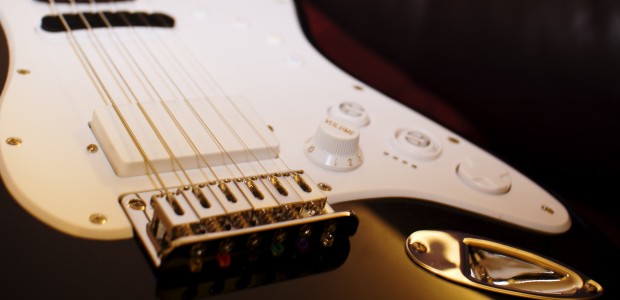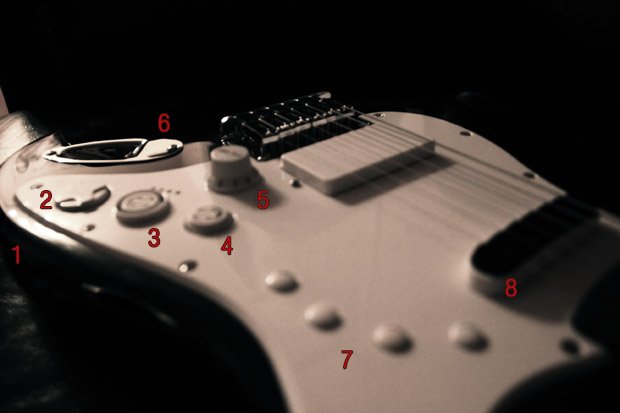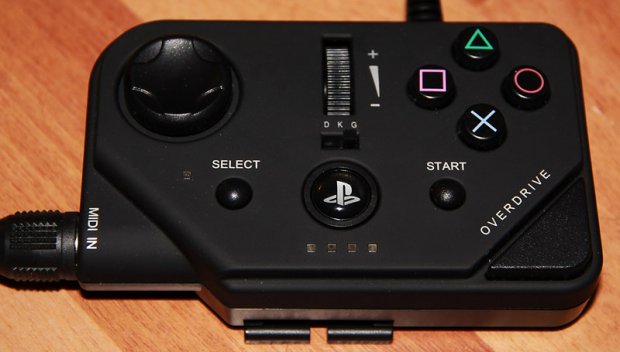Rock Band Fender Squier Stratocaster Pro Guitar Review

Back in 2005, Guitar Hero hit stores and the plastic music instrument genre blew up overnight. It wasn't the first game of it's kind, but Guitar Hero popularized plastic guitars in the North American and European markets for rockstar wannabes.
Following the release of its sequel, Guitar Hero 2, the Harmonix team was sold. They promptly began work on a spin-off game--which would ultimately become more popular than its predecessor--named Rock Band. Rock Band brought forth a few new instruments into the mix: drums, a microphone, and eventually a keyboard. The third installment of Rock Band was an effort by Harmonix to re-spark interest in a genre that began to fade away from the spotlight. The team decided to take the game to the next level by emphasizing the use of real instruments--you could add cymbals to your drum kit, attach your own keyboard (or buy the custom designed Mad Catz one), and finally, plug in a real, custom-built, Fender Strat guitar to the game.
The Hardware, a.K.A The Fender Squier Stratocaster for Rock Band (retail $279.99 USD/CAD)
The Fender Squier Stratocaster Pro Guitar for Rock Band is essentially the budget line of Strats from Fender, but there are some important differences, the biggest being the midi-out port that's built into a guitar. While the guitar does have a regular analog out jack to plug it into an amp, the midi-out is a great feature that allows you to plug it into a PC or Mac to record and edit your music with ease (helllllloo Garageband!).
You'll also notice a bunch of little colored buttons on the guitar, a directional pad, and two bigger left and right arrows. These are used to navigated through the in-game menus from your guitar. The buttons are colored instead of being labelled because the guitar actually works on the Xbox 360, PS3, and Wii; not having to buy a separate guitar for each console is a big bonus.
There's also a black bar that looks like a line of velcro. Pressing down on this bar makes it spring up and mute the strings. Why would you want to mute the strings? Because the game is highly sensitive and detects even the most minute vibration--if you strum too hard, the game might detect more than one strum.
The body of the guitar is fairly solid, except for the fretboard. It's an actual Fender, so the size is bigger than your plastic guitar and it weighs considerably more--roughly the same as a real electric guitar. As I mentioned previously, the fretboard feels cheap; it's made out of plastic and looks like it might break off at some point--but we haven't encountered any issues, nor have there been any major reports in the online community. Despite the quality of the fret, it does play a lot better than my old Japan-built Fender. You might need to open the battery compartment when you first buy the guitar to adjust some of the strings, namely the high E; I didn't need to, but there have been reports from other users who had to do it. Don't worry, this is part of maintaining a real guitar.
Wait did I say "battery compartment"? Yeah, that wasn't a typo. The guitar requires three AA (included) batteries if you're going to play it on a console. The batteries are not needed if you use it as a real guitar.
There is no whammy bar on Fender's Rock Band Squier, so the game auto-whammies for you. It does, however, have motion detection so you can still tilt the guitar to activate overdrive. Speaking of which, the detection is a LOT better in this guitar over its plastic counterparts.
Rock Band Squier Buttons

1) Midi-Out (not pictured). By plugging in the supplied midi cable, you can attach your guitar to the midi Pro-Adapter, a midi interface device, or if you use a midi-to-usb cable, you can even connect it to your Mac or PC (I've tested this with GarageBand on OSX Snow Leopard and it worked perfectly).
2) Digital Pad: A standard Up/Down/Right/Left digital pad used solely to navigate through Rock Band's menus. One little note: since you're looking down on the guitar, the up and down arrows are inverted and there's no way to change this. It's easy to get used to it, though.
3) Start Button and 4) Select/Back Button: Used solely in Rock Band to mimic the start/back/select buttons on Xbox, Playstation 3, and Wii.
5) Volume Control: A regular volume nob that's used when plugging the guitar into an external amp. Sorry, you can only crank up the volume to 10.
6) Analog Out: Use this to plug your guitar into an amp, tuner, or whatever else you'd plug your normal guitar into.
7) Colored buttons: These buttons automatically map out to your four standard buttons on the Xbox/PS3/Wii.
8) String Muter: You'll probably want to push this button down so the muter pops up and mutes your strings. If you don't do this, you might have a hard time beating songs in Rock Band due to the string vibrations being registered more than once. Just make sure that when you're ready to jam in the real world, you push this button down, or you won't hear a thing.
Continue on to the next page to find out about the Midi Pro-Adapter.
The Midi Pro-Adapter Review (retail $39.99 USD/CAD)
While the guitar is platform independent, you do need this little $40 add-on (a really hard to find add-on) in order to play on the console of your choosing. The Midi Pro-Adapter *is* console specific, so make sure you pick up the right one. There's not much to the device. It acts as a hub between your controller and your console, and converts the midi commands to ones that the console can understand and interpret. The Midi Pro-Adapter has a little switch marked "DKG" which lets you toggle between supported electronic drum kits, midi keyboards, and the Fender Squier Strat. Make sure to set the switch to "G" when you plug in the guitar--otherwise, it won't work.
Unfortunately, the device ONLY works with this guitar; you can't plug in another midi guitar to the adapter as a regular guitar lacks the special sensors found on Fender's Rock Band Strat.
The Midi Pro-Adapter also has the standard PS3/Xbox 360/Wii buttons (depending on the version) that you'd find on the console's controller (minus the Right/Left triggers). There's also a button labelled "Overdrive" which you can tap with your toe to activate Rock Band overdrive. These buttons stick out a fair bit from the adapter and, as such, are extremely easy to press when you need them.
The Midi Pro-Adapter is NOT wireless; You'll need to plug it into your console and then plug in your guitar (using the midi cable that comes with the guitar) to the device. As mentioned earlier, you'll need to also put batteries into the guitar (but not the adapter). The adapter does not transmit power; this is a bit of a bummer but not a dealbreaker, especially if you use rechargeable batteries. My only complaint with the adapter (besides availability, damn you Mad Catz!) is that, at least for the Playstation 3, it will not turn ON your console--it does turn it off, though. Other than that, it's a well-built device that works as intended.
But what about the gameplay, you ask? Keep on reading.

Gameplay
Before you start playing Rock Band 3 with your brand new Fender Squier Strat, you're going to want to do two things: 1) press the velcro-looking bar on the guitar down so that it pops up and mutes the strings, and 2) go to the Options and select Chord Numbering so that it's turned on. The first part is crucial; without the chords muted, you'll either have to palm mute every note that you play (which would be a horrible habit to form when playing real guitar) or you'll have to play extremely silently. The reason is that if you strum normally, the strings will shake and the game will detect unwanted notes. By muting the chords, you'll be playing way more accurately.
Much like the regular version of Rock Band, in Pro mode, the notes will scroll down the screen. The fret board on the screen is representative of your actual fret, with the low E (thickest or top-most string) being on the left and the high E (the thinnest or bottom string) being on the right (in standard EADGBE tuning). The notes you need to strum are represented by a number. If you see a 3 coming down on the D string, that means you need to place your finger on the third fret of the D string and strum only that string when it lines up with the bar at the bottom of the screen. It's a bit confusing when it scrolls down fast, especially for a newcomer, but you will get the hang of it.
Chords are another beast altogether. They are represented by their chord name (for example, G) on the left, and then on the actual board, you'll see the first string you need to hold down and a wave showing the other strings. This is extremely confusing and I highly recommend turning on chord numbering instead. With chord numbering on, a G chord will be shown with the actual strings you need to hold down and strum, so 3-2-0-0-0-3, as well as the letter G. You'll probably want to learn a few of the basic chords to get you started because G is a lot easier to read than 3-2-0-0-0-3.
If you're able to beat Freebird without missing a note on Expert in regular Rock Band, but you've never picked up an actual guitar in your life, get ready for a big surprise. If you thought the dreaded orange note was hard to hit before, pro mode will make your brain explode. The only takeaway the plastic instruments will give you is timing and, well, that's it. Holding down chords on a real guitar is tricky and so is plucking away at individual strings.
Get ready for pain during the first few days. If your fingers aren't calloused already, you're going to be in a world of hurt as the strings will cause your fingers to flare up. Don't worry though, after a few days of playing, your fingers will adjust and it won't hurt as much. You'll probably also want to stretch your fingers before playing as you'll have to extend your fingers far further than what you're used to.
Will Rock Band 3 teach you how to play a real guitar? The answer lies on the next page.
Learning to Play Guitar
The previous page might seem daunting to newcomers but don't worry, the game has a detailed, built-in tutorial (including a 'learn a song' feature for every track) to get guitar noobies on track. The tutorials start off with the basics and gradually shift to more complicated guitar lessons. It's very progressive and very nicely done. Within a few quick lessons, the game will jump you into The Hardest Button To Button by The White Stripes and you'll be playing the song on easy in no time. A few lessons later, they'll have you learning actual chords, practicing moving your fingers around quickly, and showing you the advantages of up-down strumming. If a lesson proves to be too difficult, you can slow down the speed of the track until you get the pattern down. The game won't let you advance until you beat each lesson three times at 100% speed with 100% accuracy. Even if you do beat a lesson at 100%, you'll probably want to retry it a few times in order to master it.
The Learn a Song mode allows you to play the track at a reduced speed (if you desire) and repeat certain sections that are proving to be more difficult. While Pro-mode does have Easy, Medium, and Hard levels of difficulty, only the Expert mode will truly reflect the actual guitar in the song. While it may seem impossible to play a song on Expert at first, if you keep at it on Easy and Medium, and progressively increase the difficulty, you'll find yourself beating the songs. Make sure to turn on No Fail mode when learning a song, though. Once you get the hang of it, you can push the velcro bar back down so that it doesn't mute your chords and plug it the guitar into an amp to hear yourself play.
Unfortunately, you're not going to become a rock legend over a weekend; it takes time, patience, and a lot of practice. When I first started the Hardest Button to Button, I was getting low scores on Medium and trying to keep up. After a few sessions, I've upgraded to Expert and play the song without even looking at the screen.The biggest sense of satisfaction and accomplishment comes when you play the guitar while your console boots up and realize that you know how to actually play the song. If you learn the main chords, how to do power chords, and how to move your hands quickly, you'll be able to play real songs in no time.
One thing of note: the game doesn't require that you tune the guitar. You'll want to invest in a tuner when you want to play for real.
I Already Know How To Play Guitar, What's The Point?
True, if you're a guitar virtuoso, the game probably isn't for you and you most likely already have a garage filled with guitars that are collecting dust. Still, why not prove how good you truly are? In March, Harmonix released Through Flames and Fire, the most difficult pro-guitar track out there. The song is so hard that the two expert guitarists that were in charge of mapping the song into the game have not been able to beat the track yet and have only gotten a score in the 30's. Check out the video below to see exactly how difficult a song can get (note the Mad Catz Mustang is used in the clip and not the Fender stringed guitar but the gameplay is the same).
Keep reading for the verdict on the Fender Strat for Rock Band.
Is Rock Band 3 Pro Guitar The Real Deal or Is It Just Fantasy?
Simply put, yes, it's the real deal. After just a couple of weeks with the Pro Guitar, I can safely say that Rock Band 3's Learn to Play an Instrument feature is one of, if not, the easiest way to learn how to play guitar (or even drums and keyboard). The tutorials do a great job of teaching you the basic chords, hammer ons, pull offs, strumming, and even more advanced skills. The visual queues are fantastic since all the little nuances (for example your pinky holding down a string by accident) are all shown. The game comes with a bunch of songs ranging from easy to expert, so there are plenty of tracks to practice on.
Having said that, the game isn't perfect. While it does a great job of teaching you how to play guitar, I do find it to be a tad too forgiving when you strum a note; if you hit an extra string, for example, it will sometimes not penalize you for it. That's fine if you're aiming for a good score but once you plug the guitar into an amp, you'll hear the mistakes. Also, muting chords and bending strings is non-present. The game does show you when you need to bend or mute a string but the Fender Strat doesn't support it (in game). It's not a deal breaker as you can easily do it when you play for real but it would have been nice if it worked in the game too.
The other problem, which is a pretty big deal for people who have been buying tracks off the Rock Band store, is that only a handful of songs work with Pro-Guitar, and those tracks also cost $1 more, bringing the cost of one song to $3. I have over 600 songs on my version of Rock Band but only 88 of them have Pro-Guitar. Assuming all those songs had the Pro-guitar for purchase (which very few do), I'd be looking at over $500 to upgrade my collection of songs that I've already bought. Luckily, most songs included in the Rock Band 3 disc come with Pro-Guitar or Pro-Bass compatibility. Speaking of Bass, the guitar doubles up as a bass in-game.
At $280 for the guitar, $40 for the Midi Pro-Adapter, and $60 for the game, you're looking at a hefty $380 investment that doesn't include the price of the console or an amp. It's also unknown whether or not the guitar will work with future Rock Band games on next-generation consoles, or even if your songs will transfer over. If you're really keen on becoming the next rockstar and you've got the cash, I highly recommend purchasing Rock Band 3 and the Fender Squier Strat Pro Guitar.